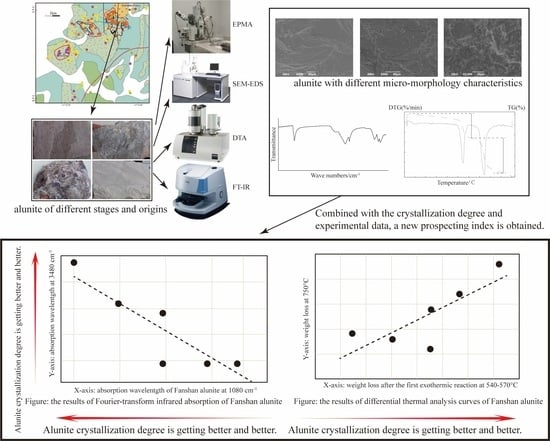Mineralogy and a New Fertility Index of Alunite in the Fanshan Lithocap, Luzong Basin, Anhui Province, China
Abstract
:1. Introduction
2. Geology of Luzong Basin
3. Geology of Fanshan Alunite Deposit
4. Mineralization and Alteration
4.1. Alterations
4.2. Alteration and Mineralization
5. Analysis Methods and Samples
6. Alunite Mineralogy and Geochemistry
6.1. Alunite Mineralogy and Microstructure
6.2. Alunite Geochemistry
6.3. Alunite FT-IR Features
6.4. Alunite DTA Results
7. Discussion
7.1. Alunite Evolution Temperature
7.2. Alunite Phase Indication
7.3. Alunite Prospecting Indication
8. Conclusions
- There are three types of alunite produced from the hydrothermal stage to the supergene stage in the Fanshan area of the Luzong basin early-stage hydrothermal alunite (IA alunite) formed during the metasomatic alteration, late-stage hydrothermal alunite (IB alunite), and supergene alunite (II alunite). As the evolution progresses, the formation temperatures of these three types of alunite gradually decrease.
- The alunite in the Fanshan area of the Luzong basin is K-alunite. The total content of K2O and Na2O in the alunite is relatively lower than in the theoretical composition of alunite, and it contains a significant amount of water. H3O-alunite [H3OAl3(SO4)2(OH)6] is present in Fanshan. The high K/Na molar ratio indicates that the formation temperature of the alunite is above 200 °C, which is consistent with the temperature characteristics of high-sulfidation deposits. This further confirms the presence of a high-sulfidation epithermal system in the Luzong basin.
- As a representative mineral in the shallow alteration system for exploring high-sulfidation or porphyry deposits, hydrothermal alunite exhibits indicative properties regarding the formation environment, SWIR characteristics, and geochemical features of hydrothermal mineralization centers. In addition to these aspects, the FT-IR spectroscopy and DTA described in this article also demonstrate their indicative role. The FT-IR spectroscopic features of alunite with larger peak values at 3480 cm−1 and smaller peak values at 1080 cm−1, as well as the DTA curve features of deeper exothermic valleys at 750°C and steeper weight loss slopes, indicate a favorable formation environment for alunite and provide valuable indications for deposit exploration and assessments of mineralization potential.
Author Contributions
Funding
Data Availability Statement
Acknowledgments
Conflicts of Interest
References
- Sillitoe, R.H. Porphyry copper systems. Econ. Geol. 2010, 105, 3–41. [Google Scholar] [CrossRef]
- Cooke, D.R.; Agnew, P.; Hollings, P.; Baker, M.; Chang, Z.S.; Wilkinson, J.J.; White, N.C.; Zhang, L.J.; Thompson, J.; Gemmell, J.B.; et al. Porphyry indicator minerals (PIMS) and porphyry vectoring and fertility tools (PVFTS)-indicators of mineralization styles and recorders of hypogene geochemical dispersion halos. In Proceedings of the Exploration 17: Sixth Decennial International Conference on Mineral Exploration, Toronto, ON, Canada, 27 October 2017; Tschirhart, V., Thomas, M.D., Eds.; pp. 457–470. [Google Scholar]
- Chang, Z.S.; Hedenquist, J.W.; White, N.C.; Cooke, D.R.; Roach, M.; Deyell, C.L.; Garcia, J.; Gemmell, B.J.; McKnight, S.; Cuison, L. Exploration tools for linked porphyry and epithermal deposits: Example from the Mankayan intrusion-centered Cu-Au district, Luzon, Philippines. Econ. Geol. 2011, 106, 1365–1398. [Google Scholar] [CrossRef]
- Li, X.X.; Zhou, T.F.; White, N.C.; Fan, Y.; Zhang, L.J.; Xie, J.; Liu, Y.N.; Xiao, X. Formation of the Fanshan lithocap and implications for exploration in the Luzong basin, Anhui Province, China. Ore Geol. Rev. 2020, 118, 103314. [Google Scholar] [CrossRef]
- Rye, R.O.; Bethke, P.M.; Wasserman, M.D. The stable isotope geochemistry of acid sulfate alteration. Econ. Geol. 1992, 87, 225–262. [Google Scholar] [CrossRef]
- Xuan, Z.Q. Resources and tapping of alunite in China. Geol. Chem. Miner. 1998, 20, 279–286, (In Chinese with English abstract). [Google Scholar]
- Li, Z.M. Status of alunite resources in China. Ind. Miner. Process. 1999, 8, 35. (In Chinese) [Google Scholar]
- Wang, X.L.; Ji, C.S.; Ren, H.B. A study of present situation of comprehensive utilization and development prospect of alunite in China. China Min. Mag. 2010, 19, 15–21, (In Chinese with English abstract). [Google Scholar]
- Bureau of Geology and Mineral Exploration of Anhui Province 327 Geological Team. Hefei: Summary Report of Geological Exploration in Dafanshan Mining Area of Lujiang Alum Mine, Anhui Province, 1962. (In Chinese)
- Zhou, T.F.; Fan, Y.; Yuan, F.; Lu, S.M.; Shang, S.G.; Cooke, D.; Meffre, S.; Zhao, G.C. Geochronology of the volcanic rocks in the Luzong Basin and its significance. Sci. China (Ser. D) 2008, 38, 1342–1353. (In Chinese) [Google Scholar]
- Zhou, T.F.; Wang, B.; Fan, Y.; Yuan, F.; Zhang, L.J.; Zhong, G.X. Apatite-actinolite-magnetite deposit related to A-type granite in Luzong basin: Evidence from Makou iron deposit. Acta Petrol. Sin. 2012, 28, 3087–3098, (In Chinese with English abstract). [Google Scholar]
- Fan, Y.; Zhou, T.F.; Yuan, F.; Tang, M.H.; Zhang, L.J.; Ma, L.; Xie, J. High sulfidation epithermal hydrothermal system in Lu-Zong volcanic basin: Evidence from geological characteristics and sulfur isotope data of Fanshan alunite deposit. Acta Petrol. Sin. 2010, 26, 3657–3666, (In Chinese with English abstract). [Google Scholar]
- Zhang, L.J. Polymetallic Mineralization and Associated Magmatic and Volcanic Activity in the Luzong Basin, Anhui Province, Eastern China. Ph.D. Thesis, Hefei University of Technology, Hefei, China, June 2011; pp. 1–289, (In Chinese with English abstract). [Google Scholar]
- Li, X.X.; Zhang, L.J.; Gao, C.S.; Xie, J.; White, N.C. Geological and geochemical characteristics of lithocap in the Lu-Zong Basin, Anhui, China. Acta Petrol. Sin. 2017, 33, 3545–3558, (In Chinese with English abstract). [Google Scholar]
- Li, X.X.; Zhou, T.F.; Fan, Y.; Liu, Y.N.; Chen, J.; Zhang, L.J.; White, N.C.; Xie, J. Geochronology and geological significances of Fanshan lithocap in Luzong basin, Anhui Province. Acta Petrol. Sin. 2019, 35, 3782–3796, (In Chinese with English abstract). [Google Scholar]
- Li, X.X.; Zhou, T.F.; White, N.C.; Fan, Y.; Chen, J.; Liu, Y.N. Genesis of Fanshan lithocap, Luzong volcanic basin, Anhui Province, China-indications from alunite and pyrite isotopes. Ore Geol. Rev. 2020, 127, 103802. [Google Scholar] [CrossRef]
- Zhou, T.F.; Fan, Y.; Wang, S.W.; White, N.C. Metallogenic regularity and metallogenic model of the Middle Lower Yangtze River Valley Metallogenic Belt. Acta Petrol. Sin. 2017, 33, 3353–3372, (In Chinese with English abstract). [Google Scholar]
- Chang, Y.F.; Liu, X.P.; Wu, Y.C. The Copper-Iron Belt of the Lower and Middle Reaches of the Changjiang River; Geological Publishing House: Beijing, China, 1991; pp. 1–312. (In Chinese) [Google Scholar]
- Zhai, Y.S.; Yao, S.Z.; Ling, X.D. Regularities of Metallogenesis for Copper (Gold) Deposits in the Middle and Lower Reaches of the Yangtze River Area; Geological Publishing House: Beijing, China, 1992; pp. 1–120. (In Chinese) [Google Scholar]
- Ren, Q.J.; Liu, X.S.; Xu, Z.W.; Hu, S.X.; Hu, W.X. Mesozoic Volcanic Tectonic Depression and Its Mineralizing Process in Lujiang-Zoyang Area, Anhui Province; Geological Publishing House: Beijing, China, 1991; pp. 1–206. (In Chinese) [Google Scholar]
- Lu, S.M.; Li, J.S.; Tang, J.F. Preliminary study on metallogenetic geological conditions and background of the concentrating area of volcanic rock ores around Luzong. In Proceedings of the East China Six Provinces One City Geoscience Science and Technology Forum, Hefei, China, 15–17 November 2007; pp. 116–119, (In Chinese with English abstract). [Google Scholar]
- Zhou, T.F.; Fan, Y.; Yuan, F.; Song, C.Z.; Zhang, L.J.; Qian, C.C.; Lu, S.M.; David, R.C. Temporal spatial framework of magmatic intrusions in Luzong volcanic basin in East China and their constrain to mineralizations. Acta Petrol. Sin. 2010, 26, 2694–2714, (In Chinese with English abstract). [Google Scholar]
- Bureau of Geology and Mineral Exploration of Anhui Province 327 Geological Team. Hefei: Fanshan Town, Jangjunmiao 1:50000 Regional Geological Survey Report, 1981. (In Chinese)
- Bureau of Geology and Mineral Exploration of Anhui Province 327 Geological Team. Hefei: Yijinqiao, Zongyang County, Tanggou Town 1:50000 Regional Geological Survey Report, 1985. (In Chinese)
- Bureau of Geology and Mineral Exploration of Anhui Province 327 Geological Team. Hefei: Shengqiao, Huailinzui, Shijianbu, Lujiang County, Kaichengqiao 1:50000 Regional Geological Survey Report, 1988. (In Chinese)
- Bureau of Geology and Mineral Exploration of Anhui Province 327 Geological Team. Hefei: Niubu, Zhoutan 1:50000 Regional Geological Report, 1994; pp. 1–276. (In Chinese)
- Zhou, T.F.; Song, M.Y.; Fan, Y.; Yuan, F.; Liu, J.; Wu, M.A.; Qian, C.C.; Lu, S.M. Chronology of the Bajiatan intrusion inthe Luzong basin, Anhui, and its significance. Acta Petrol. Sin. 2007, 23, 2379–2386, (In Chinese with English abstract). [Google Scholar]
- Fan, Y.; Zhou, T.F.; Yuan, F.; Qian, C.C.; Lu, S.M.; Cooke, D. LA-ICP-MS zircon U-Pb ages of the A-type granites in the Lu-Zong (Lujiang-Longyang) area and their geological significances. Acta Petrol. Sin. 2008, 24, 1715–1724, (In Chinese with English abstract). [Google Scholar]
- Fan, Y.; Qiu, H.; Zhou, T.F.; Yuan, F.; Zhang, L.J. LA-ICP MS zircon U-Pb dating for the hidden intrusions in the Lu-Zong basin and its tectonic significance. Acta Geol. Sin. 2014, 88, 532–546, (In Chinese with English abstract). [Google Scholar]
- Wang, B.; Zhou, T.F.; Fan, Y.; Chen, J.; Liu, Y.N.; Chen, Y. Breccia, hydrothermal alteration and structural geology of the Huangtun deposit in the Middle-Lower Yangtze Metallogenic Belt, Eastern China. Ore Geol. Rev. 2020, 120, 103414. [Google Scholar] [CrossRef]
- Zhou, T.F.; Wu, M.A.; Fan, Y.; Duan, C.; Yuan, F.; Zhang, L.J.; Liu, J.; Qian, B.; Pirajno, F.; Cooke, D.R. Geological, geochemical characteristics and isotope systematics of the Longqiao iron deposit in the Lu-Zong volcano-sedimentary basin, Middle-Lower Yangtze (Changjiang) River Valley, Eastern China. Ore Geol. Rev. 2011, 43, 154–169. [Google Scholar]
- Liu, Y.N.; Fan, Y.; Zhou, T.F.; Xiao, X.; White, N.C.; Thompson, J.; Hong, H.L.; Zhang, L.J. Geochemical characteristics of magnetite in Longqiao skarn iron deposit in the Middle-Lower Yangtze Metallogenic Belt, Eastern China. Miner. Depos. 2019, 54, 1229–1242. [Google Scholar] [CrossRef]
- Fan, Y.; Liu, Y.N.; Zhou, T.F.; Zhang, L.J.; Yuan, F.; Wang, W.C. Geochronology of the Nihe deposit and in the Lu-Zong basin and its metallogenic significances. Acta Petrol. Sin. 2014, 30, 1369–1381, (In Chinese with English abstract). [Google Scholar]
- Zhou, T.F.; Fan, Y.; Yuan, F.; Wu, M.A.; Zhao, W.G.; Qian, B.; Ma, L.; Wang, W.C.; Liu, Y.N.; White, N.C. The metallogenic model of Nihe iron deposit in Lu-Zong Basin and genetic relationship between gypsum-salt layer and deposit. Acta Geol. Sin. 2014, 88, 562–573, (In Chinese with English abstract). [Google Scholar]
- Liu, Y.N.; Fan, Y.; Zhang, L.J. Precipitation mechanism, REE characteristics of anhydrite in Nihe deposit and itsrelation to mineralization. Acta Petrol. Sin. 2017, 33, 3531–3544, (In Chinese with English abstract). [Google Scholar]
- Liu, Y.N.; Fan, Y.; Zhou, T.F.; Zhang, L.J.; White, N.C.; Hong, H.L.; Zhang, W. LA-ICP-MS titanite U-Pb dating and mineral chemistry of the Luohe magnetite-apatite (MA)-type deposit in the Lu-Zong volcanic basin, Eastern China. Ore Geol. Rev. 2018, 92, 284–296. [Google Scholar] [CrossRef]
- Nie, L.Q.; Zhou, T.F.; Fan, Y.; Zhang, L.J.; Cooke, D.R.; White, N.C. Geology, geochemistry and genesis of the Makou magnetite-apatite deposit in the Luzong volcanic basin, middle-lower Yangtze river valley metallogenic belt, eastern China. Ore Geol. Rev. 2017, 91, 264–277. [Google Scholar] [CrossRef]
- Zhang, L.J.; Zhou, T.F.; Fan, Y.; Yuan, F.; Ma, L.; Qian, B. Dating of copper mineralization in Jingbian deposit and its prospecting significance in Luzong basin, Anhui Province. Acta Petrol. Sin. 2010, 26, 2729–2738, (In Chinese with English abstract). [Google Scholar]
- Zhou, T.F.; Yuan, F.; Yue, S.C.; Liu, X.D.; Zhang, X.; Fan, Y. Geochemistry and evolution of ore-forming fluids of the Yueshan Cu-Au skarn-and vein-type deposits, Anhui Province, South China. Ore Geol. Rev. 2007, 31, 279–303. [Google Scholar] [CrossRef]
- Qian, B.; Yuan, F.; Zhou, T.F.; Fan, Y.; Zhang, L.J.; Ma, L. Geology and S isotope geochemistry of Yueshan Pb-Zn deposit in Luzong basin. Miner. Depos. 2010, 29 (S1), 1–2. (In Chinese) [Google Scholar]
- Zhang, S.; Wu, M.A.; Wang, J.; Li, X.D.; Zhao, W.G.; Wei, G.H. The mineralization related with the syenite in Luzong basin, Anhui Province. Acta Geol. Sin. 2014, 88, 519–531, (In Chinese with English abstract). [Google Scholar]
- Bureau of Geology and Mineral Exploration of Anhui Province 327 Geological Team. Hefei: Investigation and Evaluation of Au-Cu Polymetallic Deposits in the Northeast Margin of Luzong Volcanic Rock Basin, Anhui Province, 2017. (In Chinese)
- Wu, C.N.; Ren, Q.J.; Yuan, H.C.; Zhang, K.J. Studies of relation between volcanic structures and background contents of gold in the northeastern Lujiang-Zongyang basin, Anhui Province. Miner. Resour. Geol. 1994, 8, 108–113, (In Chinese with English abstract). [Google Scholar]
- Pan, G.Q.; Dong, E.Y. Volcanic structures in the Lujiang-Zongyang volcanic area and their ore controlling effects. Reg. Geol. China 1983, 5, 31–37, (In Chinese with English abstract). [Google Scholar]
- Chang, L.H.; Chen, M.Y.; Jin, W.; Li, S.C.; Yu, J.J. Manual for the Identification of Thin Sections of Transparent Minerals; Geological Publishing House: Beijing, China, 2006; pp. 1–236. (In Chinese) [Google Scholar]
- Scott, K.M. Solid solution in, and classification of gossan-derived members of the alunite-jarosite family, Northwest Queensland, Australia. Am. Mineral. 1987, 72, 178–187. [Google Scholar]
- Lager, G.A.; Swayze, G.A.; Loong, C.K.; Rotella, F.J.; Richardson, J.W.; Stoffregen, R.E. Neutron spectroscopic study of synthetic alunite and oxonium substituted alunite. Can. Mineral. 2001, 39, 1131–1138. [Google Scholar] [CrossRef]
- Gaied, M.E.; Chaabani, F.; Gallala, W. Alunite characterization in the upper Eocene clay deposits of Central Tunisia: An implication to its genesis. Carbonates Evaporites 2015, 30, 347–356. [Google Scholar] [CrossRef]
- Makreski, P.; Jovanovski, G.; Dimitrovska, S. Minerals from Macedonia: XIV. Identification of some sulfate minerals by vibrational (infrared and Raman) spectroscopy. Vib. Spectrosc. 2005, 39, 229–239. [Google Scholar] [CrossRef]
- Zhong, W.Z.; Hua, S.K. Growth units of anion coordination polyhedral and crystal habits. J. Chin. Ceram. Soc. 1995, 23, 464–470, (In Chinese with English abstract). [Google Scholar]
- Stoffregen, R.E.; Cygan, G.L. An experimental study of Na-K exchange between alunite and aqueous sulfate solutions. Am. Mineral. 1990, 75, 209–220. [Google Scholar]
- Aoki, M.; Comsti, E.C.; Lazo, F.B.; Matsuhisa, Y. Advanced argillic alteration and geochemistry of alunite in an evolving hydrothermal system at Baguio, northern Luzon, Philippines. Resour. Geol. 1993, 43, 155–164. [Google Scholar]
- Stoffregen, R.E.; Alpers, C.N. Woodhouseite and svanbergite in hydrothermal ore deposits: Products of apatite destruction during advanced argillic alteration. Can. Mineral. 1987, 25, 201–211. [Google Scholar]
- Aoki, M. Mineralogical features and genesis of alunite solid solution in high temperature magmatic-hydrothermal systems. J. Geol. Surv. Jpn. 1991, 277, 31–32. [Google Scholar]
- Arribas, A.; Cunningham, C.G.; Rytuba, J.J.; Rye, R.O.; Kelly, W.C.; Podwysocki, M.H.; Mckee, E.H.; Tosdal, R.M. Geology, geochronology, fluid inclusion, and stable-isotope geochemistry of the Rodalquilar Au alunite deposit, Spain. Econ. Geol. 1995, 90, 795–822. [Google Scholar] [CrossRef]
- Lu, Q.; Wu, R.H. A mineralogical study of Changhua Tianhuang Chicken-Blood Stone. Acta Petrol. Et Mineral. 2010, 29, 56–61. [Google Scholar]
- Dai, H.; Zhang, Q.; Jiang, X.P.; Wang, Z. Gemmological and mineralogical characteristics of chicken-blood stone of alunite and quartz “Di” from Changhua. J. Gems Gemmol. 2011, 13, 27–30, (In Chinese with English abstract). [Google Scholar]
- Küçük, F.; Yildiz, K. The decomposition kinetics of mechanically activated alunite ore in air atmosphere by thermogravimetry. Thermochim. Acta 2006, 448, 107–110. [Google Scholar] [CrossRef]
- Wang, C.Z.; Jue, H.H. Mineralogical characteristics of alunite from Zijinshan gold-copper deposit. Acta Miner. Sin. 2013, 33, 329–336, (In Chinese with English abstract). [Google Scholar]
- Arancibia, G.; Matthews, S. SEM and EPMA studies of supergene and hypogene alunite as an aid to K-Ar and 40Ar/39Ar geochronology of epithermal mineral deposits. In Proceedings of the 10th Congreso Geológico Chileno, Concepción, Chile, 6–10 October 2003; p. 7. [Google Scholar]
- Arribas, A. Characterastics of high-sulfidation epithermal deposits, and their relation to magmatic fluid. Mineral. Assoc. Can. Short Course 1995, 23, 419–454. [Google Scholar]
- Ebert, S.W.; Rye, R.O. Secondary precious metal enrichment by steam-heated fluids in the crofoot-lewis hot spring gold-silver deposit and relation to paleoclimate. Econ. Geol. 1997, 92, 578–600. [Google Scholar] [CrossRef]
- Hedenquist, J.W.; Arribas, A. Exploration implications of multiple formation environments of advanced argillic minerals. Econ. Geol. 2023, 117, 609–643. [Google Scholar] [CrossRef]
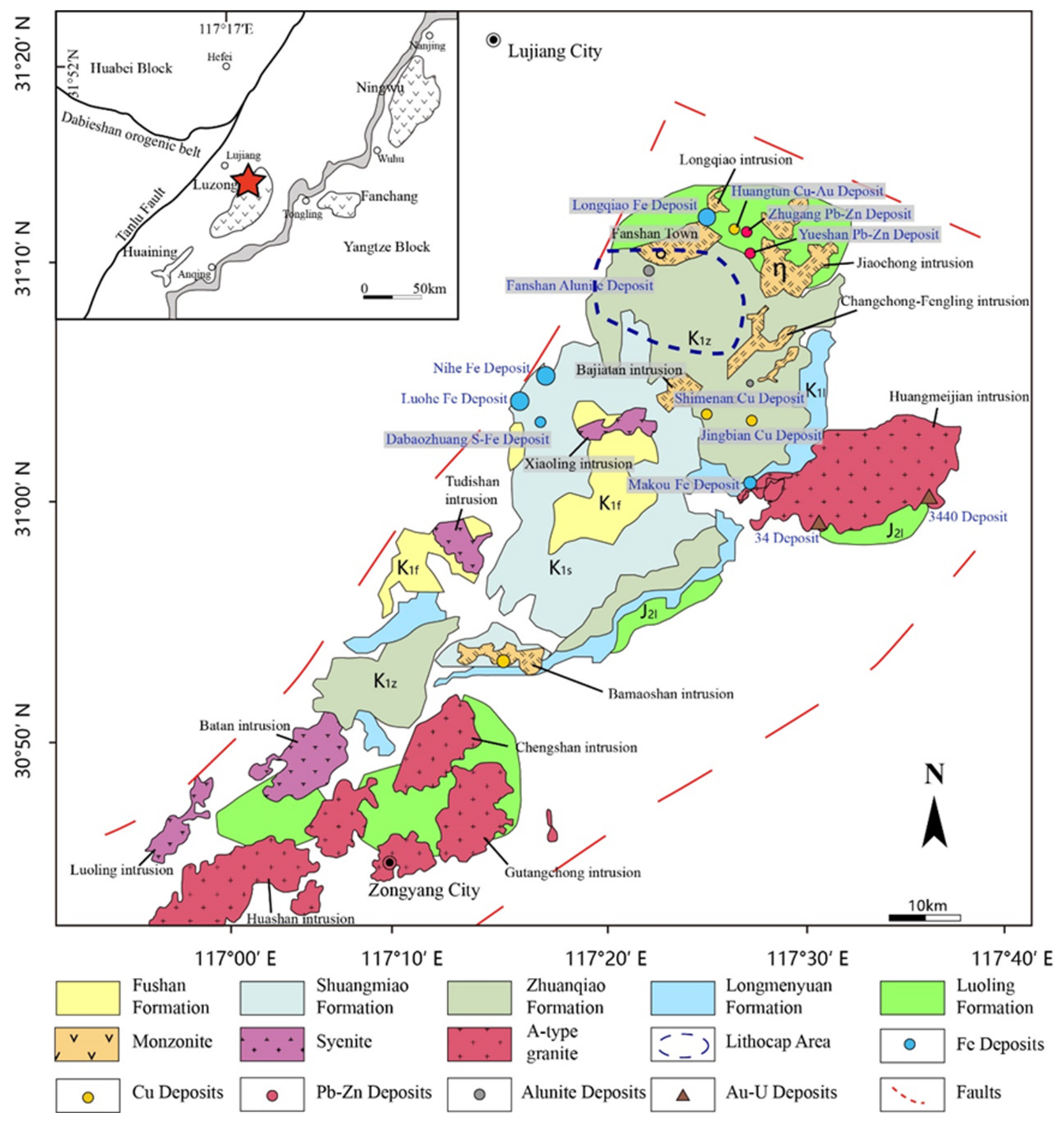

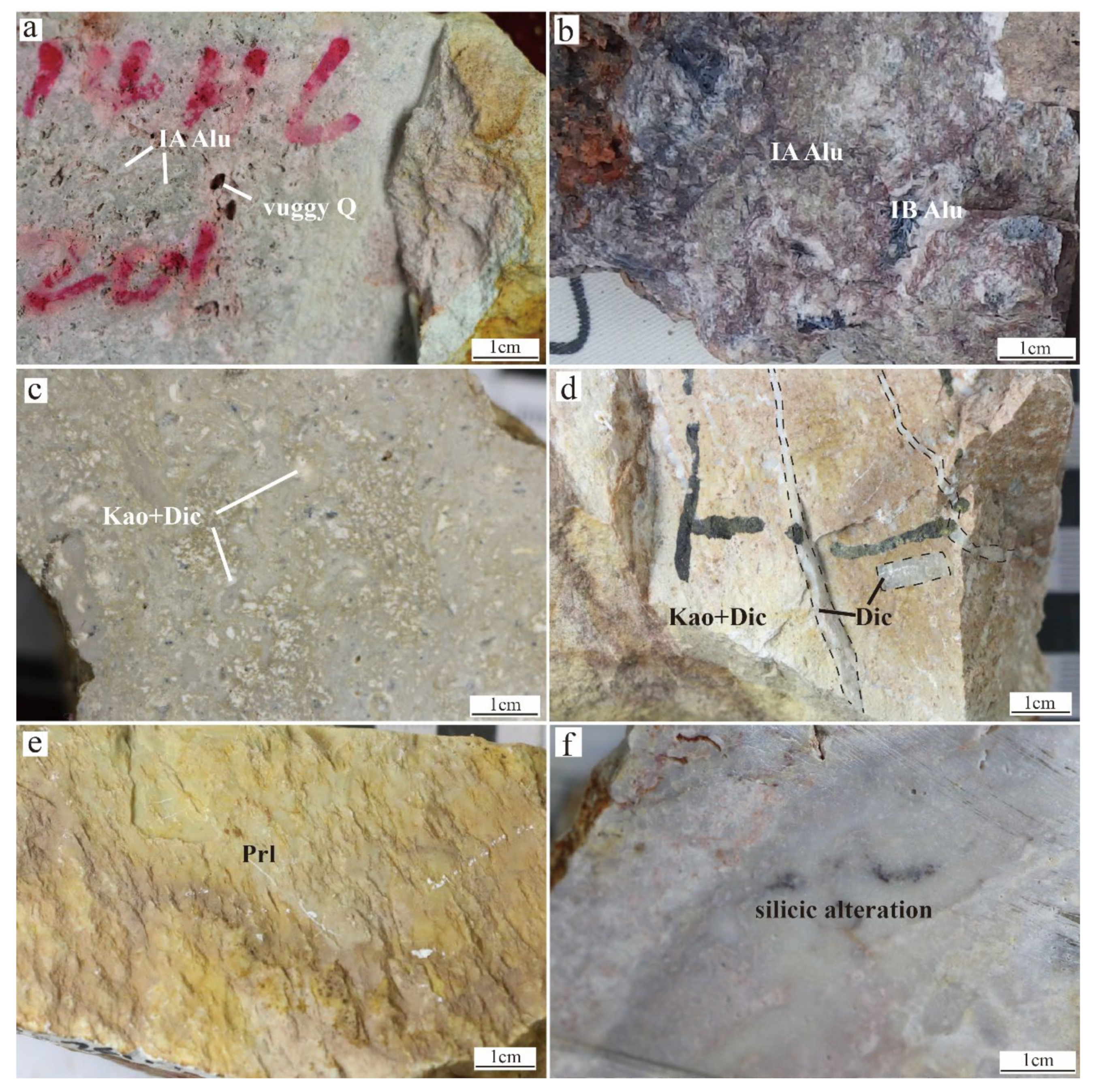



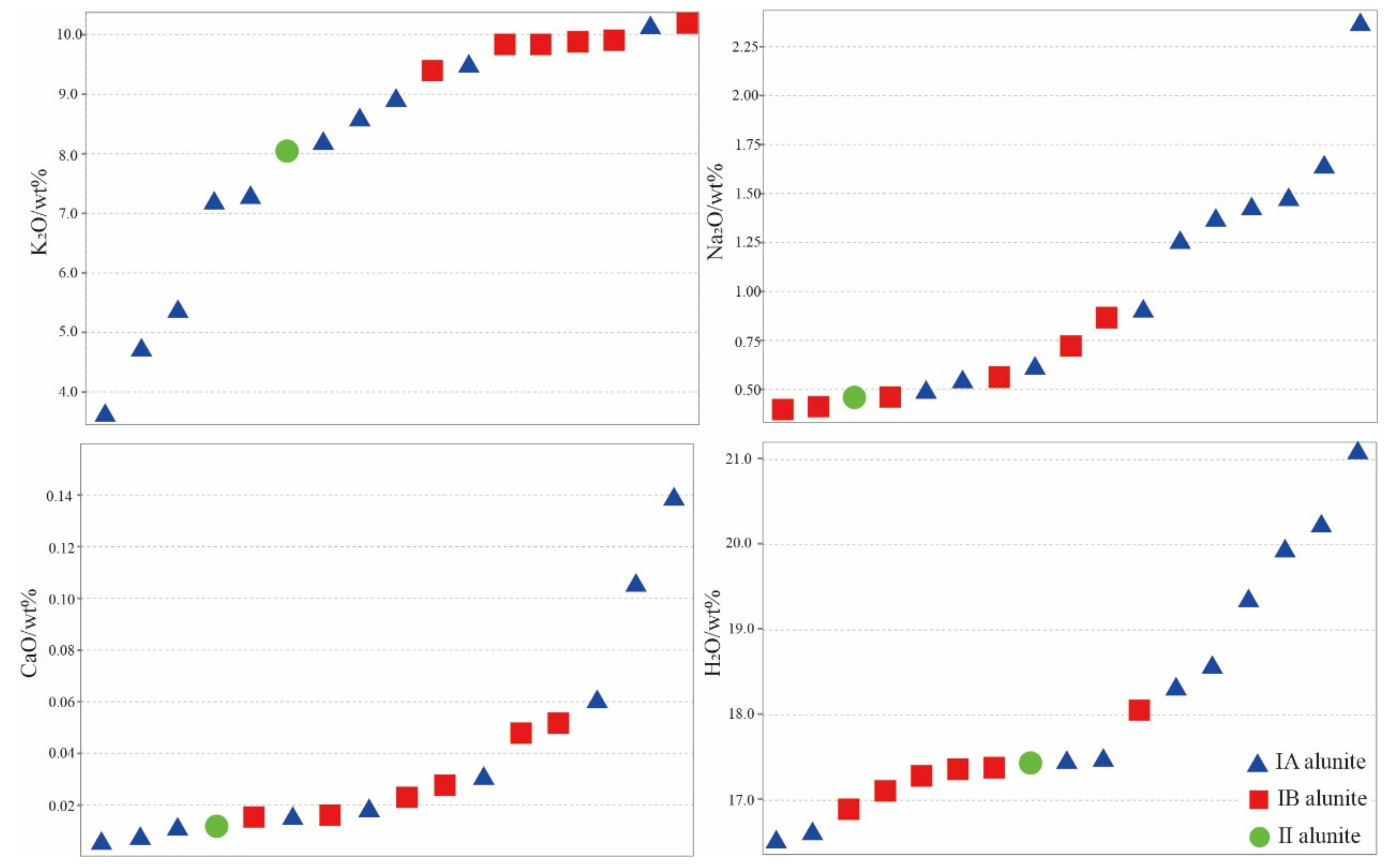

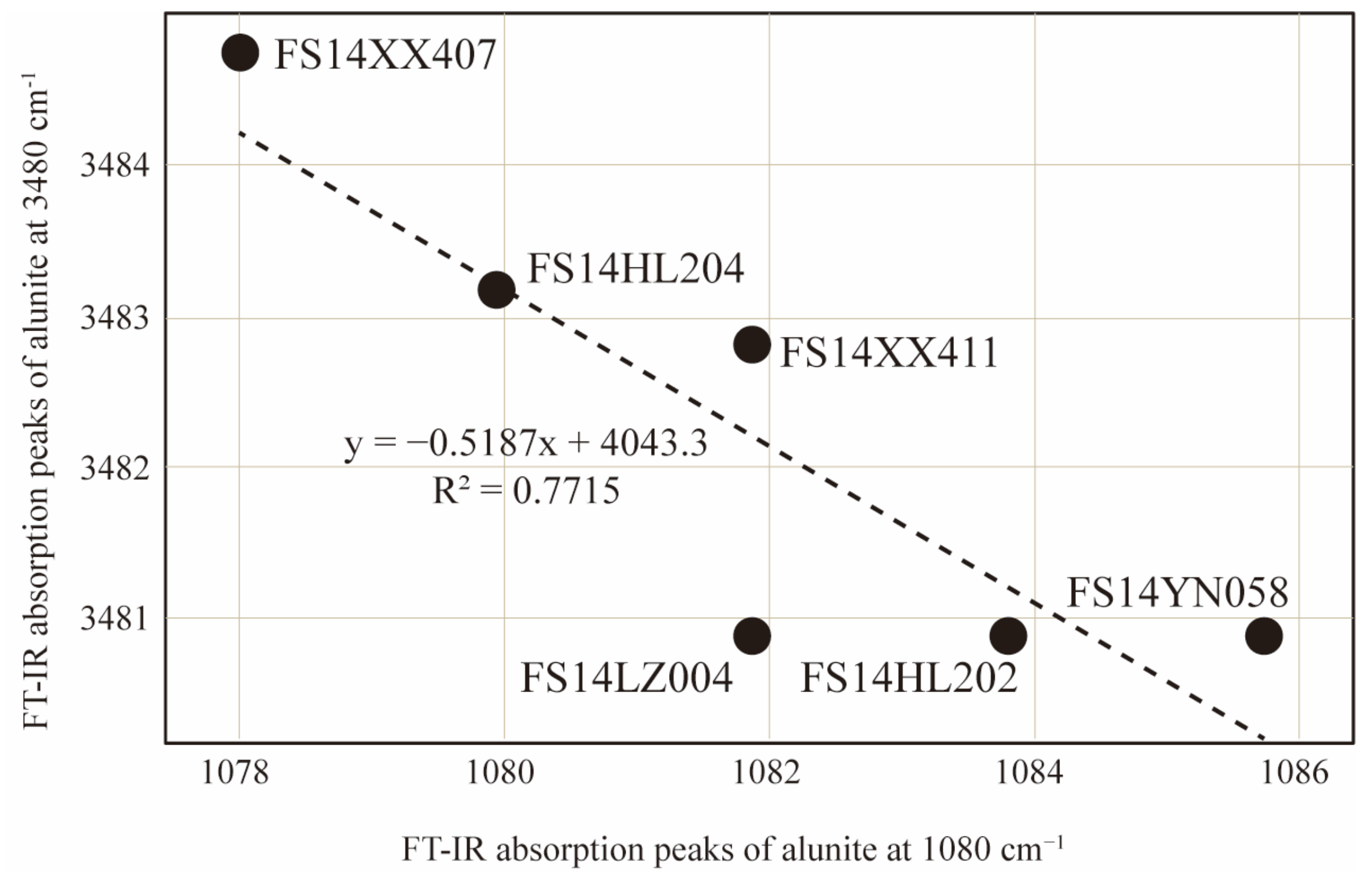
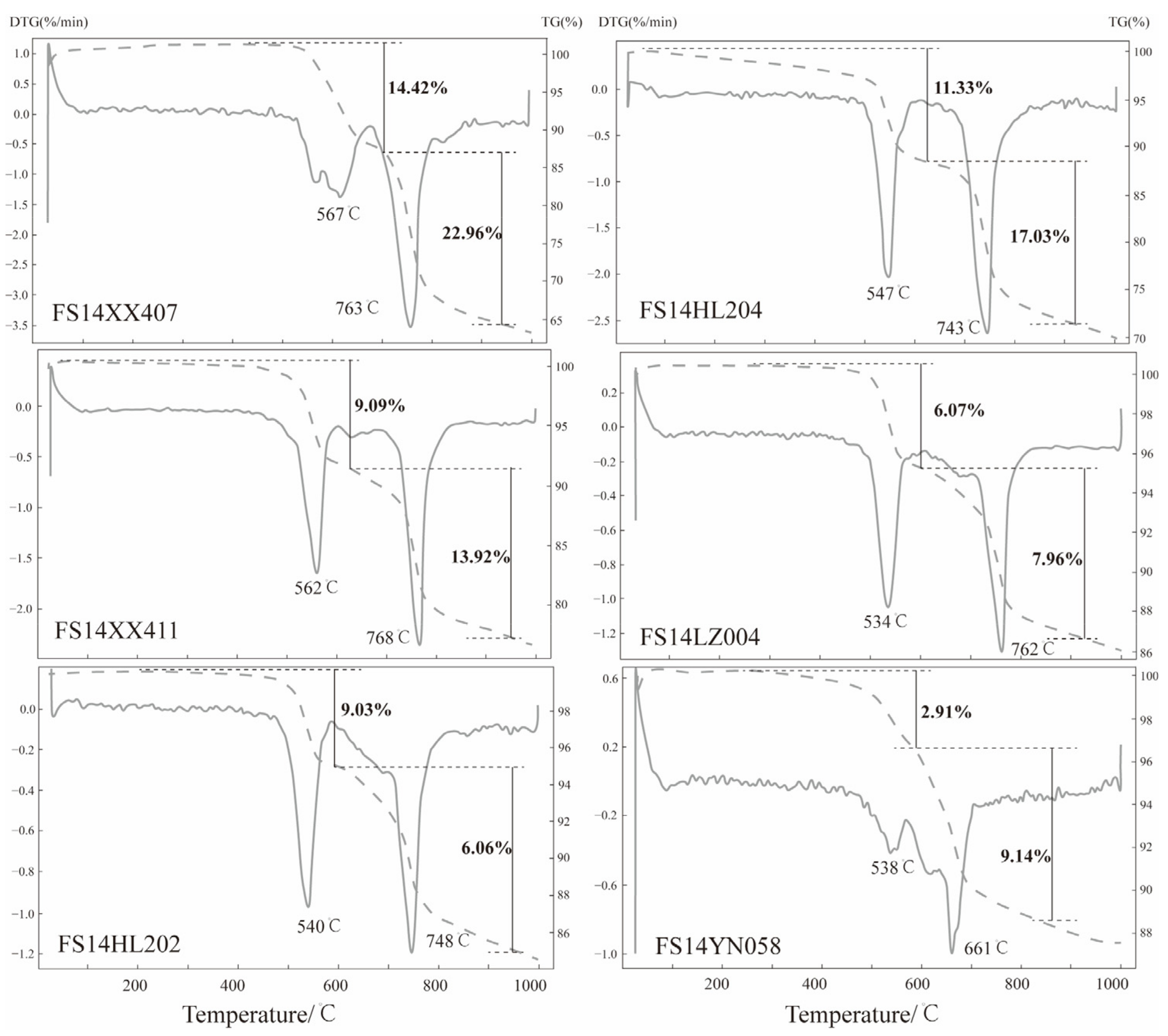
| Alunite Types | No. Samples | Al2O3 | K2O | CaO | Na2O | SO3 | FeO | Total | H2O | K/Na (mol) |
|---|---|---|---|---|---|---|---|---|---|---|
| IB | FS14XX407-1 | 35.05 | 9.88 | 0.02 | 0.56 | 37.32 | 0.04 | 82.93 | 17.07 | 19.74 |
| IB | FS14XX407-2 | 35.25 | 9.81 | 0.05 | 0.72 | 37.25 | 0.03 | 83.15 | 16.85 | 15.32 |
| IB | FS14XX407-3 | 35.34 | 9.38 | 0.03 | 0.86 | 37.09 | 0.03 | 82.76 | 17.24 | 12.15 |
| IB | FS14XX407-4 | 35.22 | 9.82 | 0.05 | 0.46 | 37.11 | 0.02 | 82.68 | 17.32 | 23.83 |
| IB | FS14XX407-5 | 35.04 | 10.18 | 0.02 | 0.41 | 36.86 | 0.03 | 82.54 | 17.47 | 27.63 |
| IB | FS14XX407-6 | 35.01 | 9.86 | 0.02 | 0.39 | 37.30 | 0.05 | 82.65 | 17.35 | 28.27 |
| IA | FS14HL204-1 | 35.56 | 8.60 | 0.01 | 1.38 | 37.93 | - | 83.50 | 16.50 | 6.98 |
| IA | FS14HL204-2 | 35.29 | 8.93 | 0.01 | 1.27 | 36.97 | 0.01 | 82.55 | 17.45 | 7.90 |
| IA | FS14HL204-3 | 35.64 | 9.50 | 0.02 | 0.91 | 37.28 | - | 83.41 | 16.59 | 11.63 |
| IA | FS14HL204-4 | 35.06 | 8.21 | - | 1.49 | 37.18 | - | 81.98 | 18.02 | 6.18 |
| IA | FS14XX411-1 | 34.93 | 10.14 | 0.02 | 0.48 | 36.09 | 0.04 | 81.70 | 18.30 | 23.49 |
| IA | FS14LZ004-1 | 35.48 | 7.30 | 0.01 | 0.54 | 36.25 | 0.06 | 79.78 | 20.22 | 15.18 |
| IA | FS14LZ004-2 | 36.13 | 7.21 | 0.03 | 0.61 | 35.87 | 0.19 | 80.10 | 19.91 | 13.13 |
| IA | FS14HL202-1 | 36.82 | 5.40 | 0.11 | 1.43 | 37.42 | 0.14 | 81.46 | 18.54 | 4.21 |
| IA | FS14HL202-2 | 37.13 | 3.65 | 0.06 | 2.38 | 37.17 | 0.10 | 80.67 | 19.33 | 1.72 |
| IA | FS14HL202-3 | 36.49 | 4.75 | 0.14 | 1.65 | 35.80 | - | 78.93 | 21.07 | 3.22 |
| II | FS14YN058-1 | 36.87 | 8.04 | 0.01 | 0.46 | 37.20 | - | 82.59 | 17.41 | 19.58 |
| Theoretical values | 36.92 | 11.37 | - | - | 38.66 | - | - | 13.05 | - | |
| Elements | FS14XX407 | FS14HL204 | FS14XX411 | ||||||||||||
| O | 43.94 | 54.40 | 44.79 | 44.50 | 51.72 | 47.29 | 48.75 | 44.46 | 50.74 | 50.23 | 40.40 | 29.91 | 52.01 | 54.15 | 60.17 |
| Al | 20.43 | 18.06 | 17.78 | 22.83 | 21.57 | 21.45 | 21.75 | 22.39 | 21.02 | 20.97 | 23.90 | 18.85 | 20.75 | 20.49 | 19.17 |
| Si | 5.36 | 4.24 | - | - | 0.81 | 1.07 | - | - | - | - | 1.35 | 6.21 | 0.16 | - | - |
| S | 21.19 | 15.20 | 24.79 | 21.71 | 16.87 | 21.02 | 19.49 | 22.76 | 17.76 | 17.83 | 22.33 | 27.39 | 17.73 | 16.59 | 13.77 |
| K | 9.08 | 6.58 | 12.18 | 10.73 | 7.69 | 8.53 | 7.23 | 8.98 | 7.19 | 6.99 | 10.52 | 17.48 | 8.49 | 8.21 | 6.28 |
| Na | - | 1.51 | 0.45 | 0.24 | 1.34 | 0.63 | 0.79 | 1.41 | 0.93 | 0.90 | 1.50 | 0.16 | 0.86 | 0.57 | 0.61 |
| K/Na (mol) | - | 2.57 | 15.96 | 26.37 | 3.38 | 7.98 | 5.40 | 3.76 | 4.56 | 4.58 | 4.14 | 64.43 | 5.82 | 8.49 | 6.07 |
| F | - | - | - | - | - | - | 1.99 | - | 2.36 | 3.09 | - | - | - | - | - |
| Elements | FS14XX411 | FS14LZ004 | FS14HL202 | FS14YN058 | |||||||||||
| O | 56.80 | 44.80 | 60.35 | 38.31 | 35.73 | 50.87 | 22.28 | 60.11 | 57.16 | 60.77 | 51.98 | 57.02 | 49.78 | 37.08 | 37.35 |
| Al | 20.34 | 21.05 | 20.51 | 25.76 | 24.21 | 21.70 | 24.03 | 14.17 | 20.60 | 19.90 | 21.96 | 20.31 | 23.75 | 24.32 | 25.15 |
| Si | - | - | - | - | 0.02 | - | - | - | - | - | - | - | - | - | |
| S | 15.17 | 21.65 | 13.60 | 22.85 | 26.40 | 18.65 | 36.53 | 14.05 | 15.51 | 13.50 | 18.65 | 15.99 | 18.24 | 22.17 | 23.27 |
| K | 6.98 | 11.70 | 4.61 | 12.42 | 14.50 | 8.76 | 17.42 | 4.38 | 5.07 | 3.69 | 4.30 | 3.39 | 7.53 | 16.10 | 13.79 |
| Na | 0.71 | 0.80 | 0.93 | 0.66 | - | - | - | 1.91 | 1.66 | 2.15 | 3.11 | 3.29 | 0.70 | 0.33 | 0.44 |
| K/Na (mol) | 5.80 | 8.63 | 2.92 | 11.10 | - | - | - | 1.35 | 1.80 | 1.01 | 0.82 | 0.61 | 6.34 | 28.77 | 18.48 |
Disclaimer/Publisher’s Note: The statements, opinions and data contained in all publications are solely those of the individual author(s) and contributor(s) and not of MDPI and/or the editor(s). MDPI and/or the editor(s) disclaim responsibility for any injury to people or property resulting from any ideas, methods, instructions or products referred to in the content. |
© 2024 by the authors. Licensee MDPI, Basel, Switzerland. This article is an open access article distributed under the terms and conditions of the Creative Commons Attribution (CC BY) license (https://creativecommons.org/licenses/by/4.0/).
Share and Cite
Li, X.; Xiao, Q.; Lin, X.; Li, S.; Tang, M. Mineralogy and a New Fertility Index of Alunite in the Fanshan Lithocap, Luzong Basin, Anhui Province, China. Minerals 2024, 14, 395. https://doi.org/10.3390/min14040395
Li X, Xiao Q, Lin X, Li S, Tang M. Mineralogy and a New Fertility Index of Alunite in the Fanshan Lithocap, Luzong Basin, Anhui Province, China. Minerals. 2024; 14(4):395. https://doi.org/10.3390/min14040395
Chicago/Turabian StyleLi, Xuanxuan, Qingling Xiao, Xin Lin, Shuangfei Li, and Mingying Tang. 2024. "Mineralogy and a New Fertility Index of Alunite in the Fanshan Lithocap, Luzong Basin, Anhui Province, China" Minerals 14, no. 4: 395. https://doi.org/10.3390/min14040395
APA StyleLi, X., Xiao, Q., Lin, X., Li, S., & Tang, M. (2024). Mineralogy and a New Fertility Index of Alunite in the Fanshan Lithocap, Luzong Basin, Anhui Province, China. Minerals, 14(4), 395. https://doi.org/10.3390/min14040395



